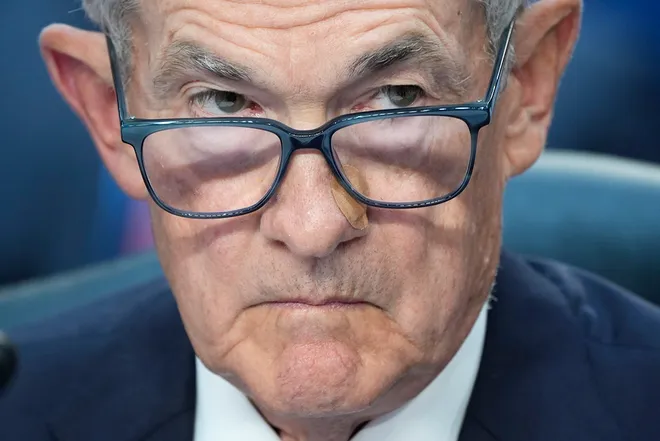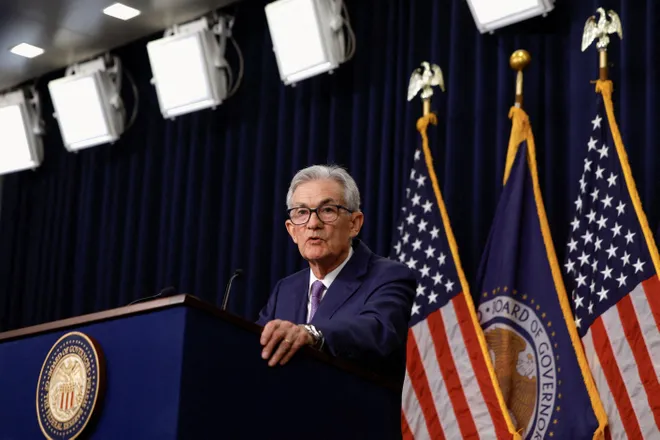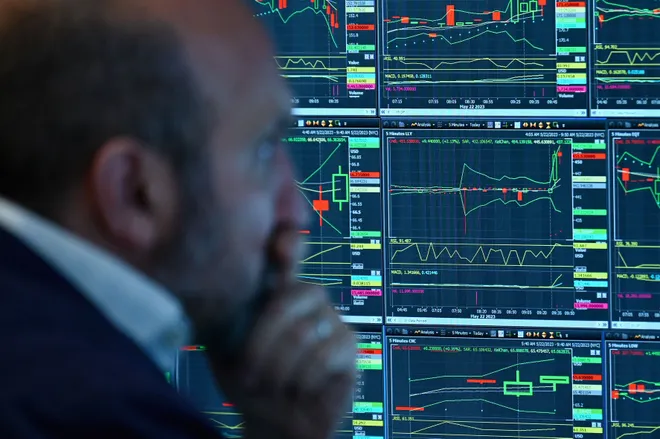Fed leaves key interest rate unchanged, signals possible rate cut in September
WASHINGTON — The Fed’s long-awaited interest rate cut – a move that’s likely to juice the U.S. economy and stock market − may be just weeks away.
The Federal Reserve held its key interest rate steady again Wednesday but signaled it could start lowering it as soon as mid-September amid easing inflation and a cooling job market.
A report Wednesday morning provided the latest evidence that wage growth is slowing, bolstering the case for rate cuts.
"The economy is moving closer to the point where it will be appropriate to reduce our policy rate," Fed Chair Jerome Powell said at a news conference. "That time is drawing near. That time could be in September if the data support that."
Powell added that inflation has come down notably in recent months, adding, "It's just a question of seeing more good data."
What happens when interest rates are lowered?
Lower rates would reduce borrowing costs for mortgages, credit cards, and auto and other loans while fueling stocks. It also would trim bank saving account yields that finally have been generating healthy returns.
In a statement after a two-day meeting, the Fed provided several hints that it believes inflation is easing and officials are growing more concerned about a flagging job market.
It said “inflation has eased over the past year but remains somewhat elevated” and there has been “some further progress” toward the Fed’s 2% inflation goal. Those are upgrades from the June statement, which simply said inflation was “elevated” and there was “modest” progress toward the 2% target.
Officials also noted the labor market has weakened, providing another reason to lower rates. “Job gains have moderated, and the unemployment rate has moved up but remains low,” the statement said.
Previously, it simply described job gains as “strong,” and didn’t mention the rising unemployment rate.
The Fed also said the “risks to achieving its employment and inflation goals continue to move into better balance. The economic outlook is uncertain, and the (Fed) is attentive to the risks to both sides of its dual mandate.” In other words, it’s just as worried about a rising unemployment rate as it is about high inflation.
In June, the central bank was more tentative, saying its employment and inflation goals “have moved toward better balance.” And it said it remained “highly attentive to inflation risks.”
At the same time, the Fed repeated that it doesn’t expect “it will be appropriate to reduce (rates) until it has gained greater confidence that inflation is moving sustainably toward” the Fed’s 2% goal. Some economists predicted the Fed would simply say it now required “somewhat” greater confidence that inflation was heading toward 2%.
Still. together, the changes reflect a Fed that seems more optimistic that a historic pandemic-induced inflation surge is softening and wants to at least open the door to an initial quarter point rate cut at a September 17-18 meeting.
Yet the government will release two more months of data on inflation and employment before that gathering. As a result, economist Ryan Sweet of Oxford Economics said in a research note that “those looking for a clear signal (of a rate cut in Wednesday’s statement) will be disappointed.”
Futures markets already were betting the Fed will trim rates three times this year, starting in September.
The Fed boosts rates to curtail borrowing and economic activity and corral inflation. It lowers rates to stimulate the economy, head off a downturn or dig the nation out of recession.
What's the Fed's interest rate today?
From March 2022 to July 2023, the Fed hiked its key rate from near zero to a 23-year high of 5.25% to 5.5% to tame the largest inflation spike in 40 years. It has stood pat the past year as consumer price increases have moderated.
But the Fed is wary of sounding overly confident following recent setbacks. Annual inflation slowed substantially last year only to flare again in the first quarter. Fed Chair Jerome Powell has repeatedly said officials are seeking a longer string of encouraging inflation data.
In May and June, inflation resumed its descent and some economists believe this pullback will be more enduring.
Prices for services such as car insurance and health care finally have risen enough to catch up to higher wholesale costs and should be moderating, Goldman Sachs says. And rents for existing tenants – which had been soaring - are starting to reflect a longstanding decline in rent for new leases, Goldman wrote in a note to clients.
Powell said the current inflation drop-off "Is a little better than what we saw last year." In 2023, he said, goods prices were falling or rising more slowly and now the cost of services is also advancing increasing less sharply.
What is the current inflation rate today?
In June, the Fed’s preferred inflation measure, which excludes volatile food and energy items, was at 2.6%, down from a peak of 5.6% in 2022 and not far above the 2% goal.
A flurry of other economic data also appears to be strengthening the argument for lower rates.
On Wednesday, the Labor Department said annual wage growth for private-sector workers fell to 4.1% in the second quarter from 4.3% in the prior three-month period, the smallest gain in three years. That’s good news for inflation because employers typically pass on their increased labor costs to consumers through higher prices.
Also this week, Labor said the number of people quitting jobs – typically a sign they feel confident about their chances of landing another one - tumbled to 3.3 million in June, the lowest level since 2020. That should mean pay increases will continue to soften, says economist Paul Ashworth of Capital Economics.
How is the US job market now?
Meanwhile, the labor market overall is still solid but cooling. Average monthly job growth has slowed to 177,000 the past three months from 267,000 early in the year. And during the first half of 2024, the unemployment rate jumped from 3.7% to 4.1%, historically low but the highest since November 2021. Hiring has fallen well below pre-COVID levels.
Although the Fed has welcomed the less frothy job market, forecasters are starting to worry that policymakers may be waiting too long before chopping rates, increasing the risk of recession.
"Our view remains that the Fed is recognizing too slowly that the labor market is cooling and that high inflation isyesterday’s problem," Ian Shepherdson, chief economist of Pantheon Macroeconomics, wrote in a note to clients. He expects the central bank to slash its key rate by a whopping 1.25 percentage points by year's end - the equivalent of five quarter point cuts - a more aggressive forecast than those published by most economists.
Powell said officials must weigh the hazards on both sides of its mandate to achieve stable prices and maximum employment,
"We are balancing the risk of (cutting rates) too soon (and reigniting inflation) and going too late," nudging the economy into a downturn," Powell said. "That is a very difficult judgement call."
Fed Live Conference:Hear Fed Chair Powell's remarks

Want to learn more? USA TODAY explains the news on interest rates. For more answers to your questions about today's report and other economic trends, keep reading:
Are rents falling in the US?
Rent increased 0.3% in June, the smallest monthly rise since August 2021. That nudged down the annual rent increase from 5.3% to 5.1%, a more than two-year low. Economists have expected rent increases to moderate, based on new leases, and that’s finally starting to happen more rapidly.
The cost of some other services also declined. Airfares fell 5% and hotel rates dipped 2%. The lower prices underscore “the post-COVID travel boom may be over," said economist Paul Ashworth of Capital Economics.
Meanwhile, bills for medical care services and car repairs each rose a modest 0.2%. But car insurance resumed a long-standing post-pandemic surge after easing in May, leaping 0.9% and 19.5% annually.
Goods prices also were generally benign. Used car prices fell 1.5%, while new cars dipped 0.2% and furniture slipped 0.9%, though appliance costs rose 0.5%. Apparel prices edged up just 0.1% following a 0.3% drop the previous month.
- Paul Davidson
Are food prices going down?
Grocery prices inched up just 0.1% in June after flattening or dipping for several months. They’re up just 1.1% annually. The prices farmers received for items such as vegetables, dairy and poultry softened in April and May, leading to drops in retail prices in June, according to Barclays and the Agriculture Department.
Prices fell for chicken by 0.2%; cereal, 1.3%; and rice, 0.4% in June. The cost of bacon was flat.
Egg prices, though, rose 3.5%, resuming a bird-flu-related advance after dropping the prior two months. Fish costs increased 2.1%, uncooked ground beef rose 1.1% and bread edged up 0.7%.
- Paul Davidson
How will stocks react to the Fed meeting?
Because few economists expect a rate cut this week, how the stock market reacts will be decided by Fed Chairman Jerome Powell’s comments after the meeting on Wednesday.
If he suggests a rate cut may be forthcoming, the stock market will likely rally, analysts said.
“Equity investors want a rate cut so earnings can continue to grow at a high rate,” said Richard Ratner, investment adviser at Bel Air Investment Advisors, a money management firm.
When interest rates are low, companies can borrow money more cheaply to invest in and grow their businesses.
On the other hand, if Powell gives “a less-than-a-full-throated support of a 25-basis-point rate cut in September, equity markets could be in for a bit of disappointment” and sell-off, said BeiChen Lin, investment strategist at Russell Investments.
- Medora Lee
How will the bond market react to the Fed?
Bond yields have already trended lower in anticipation of lower inflation and an imminent interest-rate cut.
If the Fed confirms those expectations on Wednesday, bond yields could reverse slightly. Ultimately, though, they could move even lower, especially if the Fed signals more than one rate cut might be coming, analysts said.
Drew O’Neil, broker at Raymond James, said investors may want to move money into longer-term bonds to lock in the highest yields in at least 15 years, before they drop further.
- Medora Lee
Are consumers still making purchases?
U.S. consumers account for $7 of every $10 spent in the U.S. economy.
The median monthly increase in retail sales has been 0.3% for the past 10 years. That doesn't sound like much, until you consider a 0.1% increase in November amounted to an extra $730 million in spending.
As the primary engine of the U.S. economy, consumers bought $704.3 billion worth of stuff on a seasonally adjusted basis in June. So, yes, consumers are still making purchases.
- Jim Sergent

How confident are U.S. consumers now?
The University of Michigan measures U.S. consumer sentiment on a monthly basis. The index ranged as high as 101 ahead of the pandemic in February 2020, and as low as 50 when inflation peaked at 9.1% in June 2022.
Consumer sentiment had been rising haltingly since May 2023 but tumbled in May and remains low in July, at 66.4.
Joanne Hsu, director of the surveys of consumers at the University of Michigan, wrote in the July report that sentiment "remains guarded as high prices continue to drag down attitudes, particularly for those with lower incomes."
- Jim Sergent and Daniel de Visé
Will credit card interest rates fall soon?
Even if the Fed hints that a rate cut is coming soon, as many economists predict, don’t expect a noticeable decline in credit card interest rates, analysts said.
Some banks might begin to trim their rates ahead of an official rate cut to attract new customers, but “I don’t think that is imminent,” said Matt Schulz, credit analyst at comparison site LendingTree. “And I wouldn’t expect issuers that lower their rates to do so in a big way. It’ll likely take multiple decreases over time to make meaningful change.”
- Medora Lee
When does the Fed meet again?
The remaining Fed meetings this year are:
- September 17-18
- November 6-7
- December 17-18
Many analysts anticipate a rate cut at the September meeting. In September and December, the Fed will provide updates to its economic projections. The projections are closely watched because they offer a glimpse into where Fed members see economic growth, the fed funds rate, unemployment and inflation are headed for the current year, for the subsequent three years, and for the longer run.
- Medora Lee
How the job market has responded to higher interest rates
Even though higher interest rates are making borrowing more expensive for businesses, they have continued to add jobs, but the growth might be slowing. We'll know more on Friday, when the Bureau of Labor Statistics releases the July jobs report.
The last employment report showed an increase of 206,000 workers in June, but in the same report, the Bureau of Labor Statistics revised the April and May job gains down by 111,000. All three months fell well below the 10-year median job growth of 243,000.
- Jim Sergent
What is the U.S. unemployment rate?
U.S. unemployment rate rose to 4.1% in June. The monthly number, which represents the percentage of people who are unemployed and looking for work, ticked up from 4% in May. A new unemployment number will be released on Friday.
The unemployment rate is rising slowly, which could suggest employers are pulling back on hiring. Still, the rate remains well below the 10-year monthly median rate of 4.2%. The job market had been on a similar roll in 2020 before the pandemic put millions out of work.
- Jim Sergent

Is the economy growing?
The economy picked up sharply in the second quarter, as a rise in consumer and business spending offset a drop in housing construction and a widening trade gap.
The nation’s gross domestic product, the value of all goods and services produced in the U.S., expanded at a seasonally adjusted annual rate of 2.8% in the April-to-June period, the Commerce Department reported. That’s up from a tepid gain of 1.4% early this year and a 2.5% increase for all of 2023.
The economy has been surprisingly resilient, despite high interest rates and inflation in the past two years, as a result of strong job and wage gains that have provided consumers the wherewithal to keep spending.
But cracks are beginning to show, as high borrowing costs take a bigger toll on households and companies.
- Paul Davidson
Is US consumer spending increasing or decreasing?
In the second quarter, consumer spending increased a solid 2.3% annualized, above the 1.5% pace of early this year but below the more-than-3% clip in the second half of 2023.
To fuel their purchases, Americans are spending more of their paychecks, saving about 3.8% of their monthly income, well below the average saving rate before the pandemic. As a result, they don’t have much cushion. Low and middle-income households have largely depleted their pandemic-era reserves. Credit card debt is near a record high, and delinquencies are historically elevated.
More broadly, the economy is forecast to grow less than 2% annualized the second half of the year, according to a survey by Wolters Kluwer Blue Chip Economic Indicators.
"We should receive cooler GDP reports from here on out, as consumers tighten their purse strings and businesses become more reticent to invest and hire," said Nationwide economist Oren Klachkin.
- Paul Davidson

When will mortgage rates fall?
The Fed doesn't set mortgage rates, but its actions can influence them, along with the bond market and inflation and the broader U.S. economy.
Even though the Fed hasn’t lowered interest rates in four years, inflation is easing, and bond investors anticipate a rate cut soon. That expectation has already helped push bond yields and mortgage rates lower. The average rate on a 30-year fixed mortgage is 7.24%, as of Wednesday, down from a peak above 8% last fall.
If inflation stays contained and the Fed actually begins a rate-cutting cycle, mortgages rates may head even lower, said Jacob Channel, LendingTree’s senior economist. “We might see rates trending back to their 2024 lows over the coming weeks and months,” he said. “If all goes really well, we could even end the year with the average rate on a 30-year, fixed mortgage closer to 6% than 6.5% or 7%.”
- Medora Lee and Daniel de Visé
Is inflation slowing yet?
After reaching a 40-year high of 9.1% in mid-2022, inflation eased substantially last year before unexpectedly surging again in the first quarter of this year.
In April, price gains gradually resumed a pullback. The price of goods such as used cars, furniture and appliances generally have drifted lower as pandemic-related supply-chain snarls have faded.
But the costs of services such as rent, car insurance and health care have continued to advance. That’s partly because employee wage growth was propelled by COVID-19-induced labor shortages and is slowing only gradually. Many employers have passed their higher labor costs on to consumers.
Barclays expects that, by December, yearly inflation will slow to 3% – still well above the Fed’s 2% inflationary goal.
- Paul Davidson
What will the Fed say today?
Economic forecasters don't expect the Fed to cut interest rates today. Instead, they predict the panel will comment on positive economic news and hint at the timing of future cuts, perhaps as early as September.
The Fed is likely to express “’greater confidence' that inflation is sustainably moving toward 2%,” the Fed's target for inflation, wrote Parthenon EY's chief economist Gregory Daco in a note.
But inflation won’t be the only thing on the Fed’s mind, analysts said.
“It is noteworthy that Powell has begun to emphasize the downside risks to the economy and the labor market if the Fed were to wait too long, or be too cautious, in reducing interest rates,” said Ryan Sweet, chief U.S. economist at research firm Oxford Economics.
Although recent economic data show resiliency, “consumer fundamentals may not be quite as solid as they once appeared,” said Michael Feroli, JP Morgan’s chief U.S. economist, in a report.
Coupled with easing inflation, the Fed’s two goals — maximum employment and stable prices — are coming back into balance, which economists expect the Fed to acknowledge.
But they predict the Fed will also say it needs to see more data to be sure.
- Medora Lee
The Daily Money newsletter equips you with the knowledge to spend and save smart. Sign up today.
When is the last time the Fed cut interest rates?
It seems a lifetime ago, but the last time the Federal Reserve cut interest rates was in March 2020, at the dawn of the pandemic.
The Fed unleashed much of its arsenal that month to combat the economic damage wrought by the coronavirus, cutting short-term interest rates to zero, pumping cash into the financial system and encouraging more bank loans to households and businesses.
The moves, cheered by then-President Donald Trump, were aimed at combating a recession, which forecasters considered likely.
"The virus presents significant economic challenges," Powell told reporters on a teleconference at the time.
That month, central bank policymakers agreed to lower the Fed’s benchmark federal funds rate by a full percentage point, to a range of zero to 0.25%. And that would be the last pandemic-era rate cut.
- Paul Davidson and Daniel de Visé

Why can’t the Fed give a clear timeline for rate cuts?
The Fed can't commit to cutting interest rates until several economic factors align, analysts say. Inflation is but one.
Easing inflation is a “requirement - but not sufficient on its own - for a September interest rate cut,” said James Knightley, chief international economist at Dutch bank ING.
The Fed also must see more evidence the labor market and consumer spending are softening, he said.
“We’ve seen many times this cycle that the pace of disinflation is non-linear,” said BeiChen Lin, investment strategist at Russell Investments. “Given that the labor market and economic activity in the U.S. are still relatively robust for now, I think Powell may give only muted hints about the policy action in September.”
The unemployment rate in June inched up to 4.1%, the highest since November 2021, mostly because more people are looking for jobs, not losing jobs, Knightley said.
Meanwhile, consumer spending remains resilient, growing a solid 2.3% annualized from April through June, above the 1.5% pace of earlier this year, but just below the more-than-3% clip in the second half of 2023.
- Medora Lee
What is the fed funds interest rate today?
The benchmark short-term federal funds target rate stands at a 23-year high, expressed as a range from 5.25% to 5.5%. That means Americans have been paying higher interest rates on mortgages, credit cards and auto loans. But consumers have also benefitted from more generous bank savings yields, after years of meager returns.
Since March 2022, the central bank has hiked the fed funds rate 11 times, from near zero, to corral a spike in pandemic-induced inflation. But the panel has left the rate unchanged since July 2023.
Forecasters don't expect the Fed to act on interest rates today.
- Medora Lee

S & P 500 jumps ahead of interest rate announcement
Stocks were up Wednesday morning, ahead of the Fed decision on interest rates, largely on the strength of renewed market enthusiasm over the tech industry.
The Dow Jones Industrial Average was up about 0.1% shortly after the start of trading. The S&P 500 was up 1.2%. The Nasdaq Composite was up 2.1%.
Advanced Micro Devices, the semiconductor company, was leading a tech stock rally, following a promising earnings report and high hopes for growth in the AI chip market. AI powerhouse Nvidia soared more than 10% on the same news.
- Daniel de Visé
Japan interest rates raised to unseen levels
Even as American markets brace for interest rate cuts this fall, the Bank of Japan raised interest rates Wednesday to levels unseen in 15 years.
Japan's shift to tighter monetary policy contrasts sharply with the broad swing to lower interest rates by other major economies, with the Fed expected to signal that it will cut rates in September as U.S. price pressures moderate.
The Japanese rate hike, which dashed dominant market expectations for no change, was the largest since 2007 and came just months after the BOJ ended eight years of negative interest rates as the bank's chief seeks to dismantle his predecessor's unorthodox policies.
BOJ Governor Kazuo Ueda did not rule out another hike this year and stressed the bank's readiness to keep raising borrowing costs to levels deemed neutral to the economy. The hawkish comments pushed the dollar below 151 yen for the first time since March, as markets awoke to the reality that Japan was finally eyeing a full-fledged rate hike cycle.
- Reuters
Current inflation rate 2024
Inflation eased more than expected in June, as falling gasoline prices offset another increase in rent, providing a third straight month of relief for Americans struggling with a pandemic-related spike in prices.
The development, combined with a recently cooling job market, should bolster the case for the Federal Reserve to cut interest rates in the next couple of months − a move that likely would juice the economy and U.S. stocks.
Overall prices rose 3% in June from a year earlier, a third-straight monthly pullback, according to the Labor Department’s consumer price index, a broad gauge of goods and services costs. That’s the smallest rise in a year. On a monthly basis, costs edged down 0.1% after flatlining in the previous month.
The price of used cars and airfares dropped, while grocery and health care costs rose modestly.
- Paul Davidson
Are interest rates going down?
This week’s Federal Reserve meeting probably won’t yield an interest rate cut, but it will likely lay the groundwork for one in September, most economists predict.
The Fed’s benchmark, short-term rate has stood at a 23-year high of 5.25% to 5.5% since July 2023, as the Fed waits for inflation to cool further. Annual inflation dipped in June to 3.0%: far below the two-decade high of 9.1% in June 2022, but still above the Fed’s 2% goal.
Most economists expect only hints of future Fed actions from the panel today, when its two-day policy meeting ends. They believe that inflation is trending in the right direction, and that two more months of cooler inflation reports will give the Fed room to ease rates.
Interest rate cuts on the horizon?Will the Fed cut rates this week? Key economic news guiding in their decision

But “the hint will be subtle,” wrote Ryan Sweet, chief U.S. economist at research firm Oxford Economics, in a note. “Those looking for a clear signal will be disappointed.”
Interest rates are the main tool the Fed uses to lower inflation. High rates make borrowing more expensive, which slows spending and the economy, generally easing price hikes.
- Medora Lee
Disclaimer: The copyright of this article belongs to the original author. Reposting this article is solely for the purpose of information dissemination and does not constitute any investment advice. If there is any infringement, please contact us immediately. We will make corrections or deletions as necessary. Thank you.







